Verified Times?
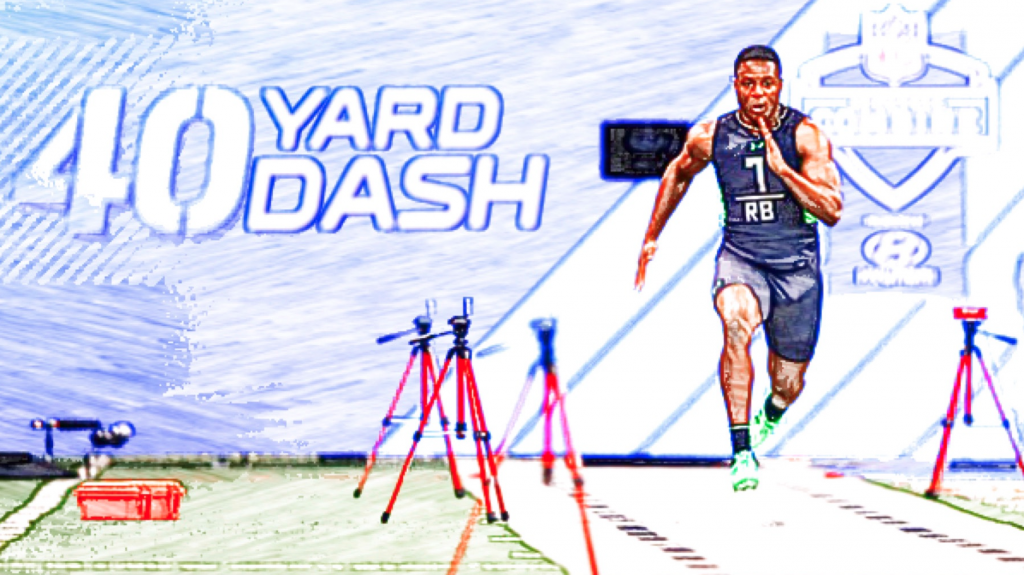
VERIFIED means “to make sure or demonstrate that something is true, accurate, or justified.” Are 40 yard dash times ever true, accurate, or justified?
In this article, I will defend the 40, but also expose the truth and fiction about 40 times. It’s a wicked, twisted, rabbit hole. Enjoy…
Why the Forty?
Timing the 40 yard dash is the cornerstone of Feed the Cats since its beginning in 1999.
♦ The 40 is a five-second sprint and anything you do for more than five seconds WILL NOT GET YOU FASTER. Running laps will make you slow, not fast. Conditioning will make you slow, not fast.
♦ The 40 has two phases, acceleration and max speed. There is nothing else. Sprinters are either accelerating to max speed or they are maintaining max speed. Football values this metric above all others. Among football players of similar size and ability, the 40 will be the #1 KPI (Key Performance Indicator). Even among offensive tackles, the fastest big guys at the NFL Combine will be the first round picks. See Big Cats, Not Hogs.
♦ If a track coach wants to attract football players to his track program, the 40 is the bait. If you have no football players on your track team, you will have a team consisting of nerds from the marching band and distance kids from cross country. (Not that there’s anything wrong with the marching band or cross country!)
The Early Days
I made some mistakes when I first started.
♦ I used to carry a measuring tape to mark off 40 yards. Dumb. Boys hurdle marks are 10 yards apart.
♦ At first, I did NOT allow spikes. Why? Well, the scientist in me wanted “pure” data. Dumb. Our goal should be sprinting at a speed never before achieved. Wearing spikes allows the body to feel a new velocity and adapt. The CNS becomes hardwired to the muscle fibers of the sprinter and the athlete becomes FASTER. My guys carry their spikes in their book bags. A sprinter without spikes is like a Chicagoan without a winter coat. Dumb.
♦ At first, I mandated a three-point stance. Why? Again, I wanted my data to be pure, all variables controlled. Now I allow my guys to do a three-point or two-point (everyone chooses the two-point). Why not? It’s faster and most athletic acceleration begins in a two-point. Even in track, my outgoing sprinters in the 4×1, 4×2, and 4×4 are all in a standing (leaning) two-point stance.
Timing System Evolution
♦ From 1999-2009, I timed with a stopwatch.
♦ From 2009-2014, I timed with a stopwatch and also timed the final ten meters of the 40y dash a Summit/Brower system.
♦ From 2015-2018, I timed with a stopwatch and also timed the final ten meters of the 40y dash with Freelap. (I often get asked, which Freelap should I buy?)
♦ In 2019, I ditched my stopwatch and went 100% automated with Freelap, no longer timing the final ten meters. Now, we time flys on a different day. See The Origin, Evolution, and Future of Record, Rank, and Publish.
Why did it take twenty years to go automated, even when I had the equipment to do so?
♦ 20 years of data would become obsolete. This is huge to me.
♦ The “pressure pad” of my first system and the “thumb pad” of my present system makes it hard to run ten 40s in one minute. With the pad, everything slows down. If you have 40-50 kids, timing 40s with the Freelap Tx Touch Pro would take forever. Timing 50 kids (150 40s) would take up to 50 minutes with the thumb pad, more like 20 minutes my way. (The way we do it now allows us run 40s as fast as we can record them!)
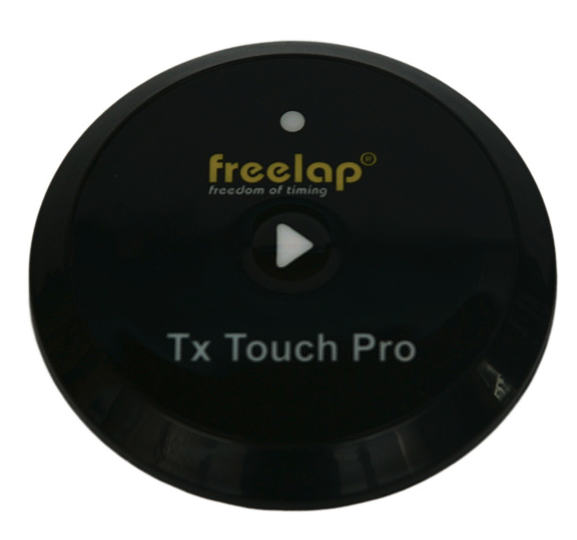
Brad Dixon gets tons of emails asking about his innovative football programming that emphasizes sprinting and resting instead of grinding. Recently he wrote They Just Want the Damn Recipe! Lately, my inbox has been full of timing questions. Well, here’s the recipe.
My Recipe
This is how I now time the 40 in a group setting.
♦ Freelap “start cone” placed five feet in front of starting line.
♦ Freelap “finish cone” placed three feet past the finish line.
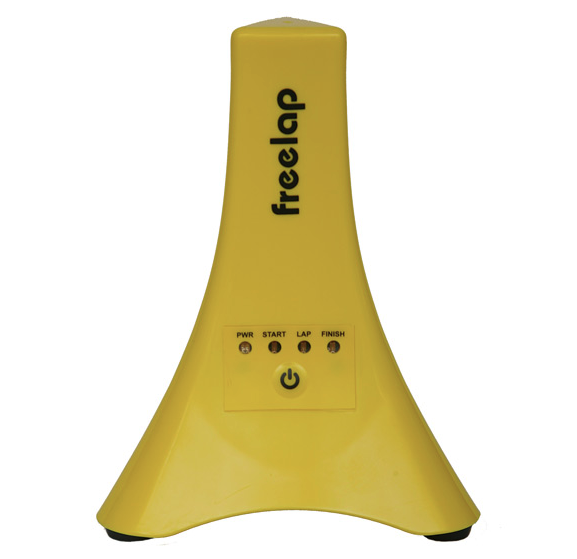
But why the five-feet and three-feet deal?
First of all, understand that the Freelap cones have an 80 cm magnetic field (31.5 inches). You can’t put a Freelap cone at the starting line because the chip would already be activated. The cone must be at least 31.5 inches in front of the starting line.
Secondly, I have experimented with different settings and found that five-feet and three-feet produces 40 times that match my stopwatch time. For those of you new to track and field timing, hand-held (stopwatch) times are 0.24 seconds faster than Fully Automated Timing (FAT). FAT begins at the nanosecond that the gun is fired. Hand-held timing does not begin until the visible smoke from the starter’s gun travels to the eyeballs of the timer, a nerve impulse travels to the index finger, and the index finger squeezes the button on a stopwatch. It typically takes 0.24 seconds for the smoke of the starter’s gun to reach the stopwatch.
I now collect automated times that match my previous 20 years of stopwatch times. In other words, someone who runs a 4.50 on my stopwatch, also runs a 4.50 automated. And it’s extremely reliable and efficient.
But, But, But …
But Your Times Are Not True!
Yeah, Yeah, Yeah …
No, our times are NOT verified FAT times, and I don’t care! The times are consistent with MY DATA. My times match the 200,000 forties that I’ve timed in the last 20 years. That’s a lot of 40s!
Do these times match the times that athletes will run at a combine? Of course not. Again, I don’t care! (Here’s our 40 times from 2018, the year we broke the Illinois state record in the 4×1.)
My son, Alec, gives me hell about my method. At our recent Feed the Cats Seminar in Wichita, he called out his old man for timing “the 38”. I think he actually referred to our sacred 40s as “The 38 Yard Fly”. (As usual, he’s right, we are timing an automated 38.2 yard dash) His school, Edwardsville, times with a Freelap thumb pad giving FAT times that look super slow compared to mine. (Why are coaches so damn competitive!)
BTW, if a fast kid (1.00 in 10m fly) is running 65 inches short of a 40 yard dash, his time would be .16 seconds faster. For my fastest kids, that means a 4.40 is actually a 4.56 FAT 40. (I told you, this is a wicked, twisted rabbit hole.)
But that’s not the only reason Edwardsville’s 40-times are slower. They also run on carpet without spikes.
Even if they switched to the so-called “38 Yard Fly”, Plainfield North’s times would still be faster. Why? Surface and spikes.
Why does Edwardsville put the thumb pad at the starting line and the finish cone 80 cm past the finish? They are doing an exact, fully-automated 40 yard dash. Their data is pure and meaningful for their athletes and coaches.
“The problem with both of our methods is that kids want to tell people (like recruiters) their 40 time. Your kids would be lying if they gave their 40 time. My kids would never tell anyone their time because they’re too embarrassed. Both are bad.” – Alec Holler
Hmmm … what if we all just understand that 40 times can’t be trusted? What if there was a better way to verify speed from school to school? What if we could find trusted, accurate, verified times? Hmmm … keep reading.
Here’s the point. 40s have too many variables to be compared from venue to venue. Pure verified data from venue to venue is a myth. It’s dumb to compare. Just like my early mistakes in data collection, this ain’t a scientific study. This is simply sprinting at maximum speeds and collecting in-house data. My data is my data. Your data is your data. This is not a pissing contest!
We run our 40s on a hard track, with spikes, a two-point stance, with a rolling, leaning start. We are NOT doing these things to cheat the system. I publish my data to add meaning and significance to what WE do. It’s not a competition with other schools. We race in the spring.
Why would I choose fast-looking times over slow-looking times? Duh. I want kids thinking they are fast, believing they are fast. My kids know their times are NOT comparable to the NFL Combine, but still, 4.47 sounds better than 4.71.
For example, Marcellus Moore, the fastest sprinter in Illinois history ran an average 40 time last year of 4.21 (at Plainfield North). At a spring combine in the St. Louis area, Marcellus ran 4.35 laser-timed. Does that mean the conversion factor is +.14? Maybe. Or is it +.16? Or is it +.24?
Even combines are different. Shoes? Hard turf or spongy turf? Timing system?
This spring I’m training a Big Ten running back who hopes to get drafted. His best career 40 time was 4.51 but he said it was wind-aided. So many variables!
I recently spoke with Braden Jones who ran for me at Harrisburg. Braden won three gold medals at the 2001 IHSA State Meet and is now an orthopedic surgeon. Braden was an amazing athlete, long jumping 23’4″ and running 48.8 in the 400 despite weighing 210 as a senior.
Braden started at linebacker for Northwestern before transferring to SIU where he became a star at tight end. He later played for the Vikings.
His freshman year at Northwestern, Braden ran an electronic 4.43. At his “pro-day” (at almost 6’4″ and weighing 265 pounds), Braden Jones ran 4.55, vertical jumped 39’5″, and had a standing long jump of 10’6.5″. That’s NFL-elite for a big tight end.
What was Braden’s hand-held 40 time for me? Weighing over 250 pounds, on a hard track, with spikes, and a two-point stance, Braden Jones ran back-to-back stopwatch-timed 4.29.
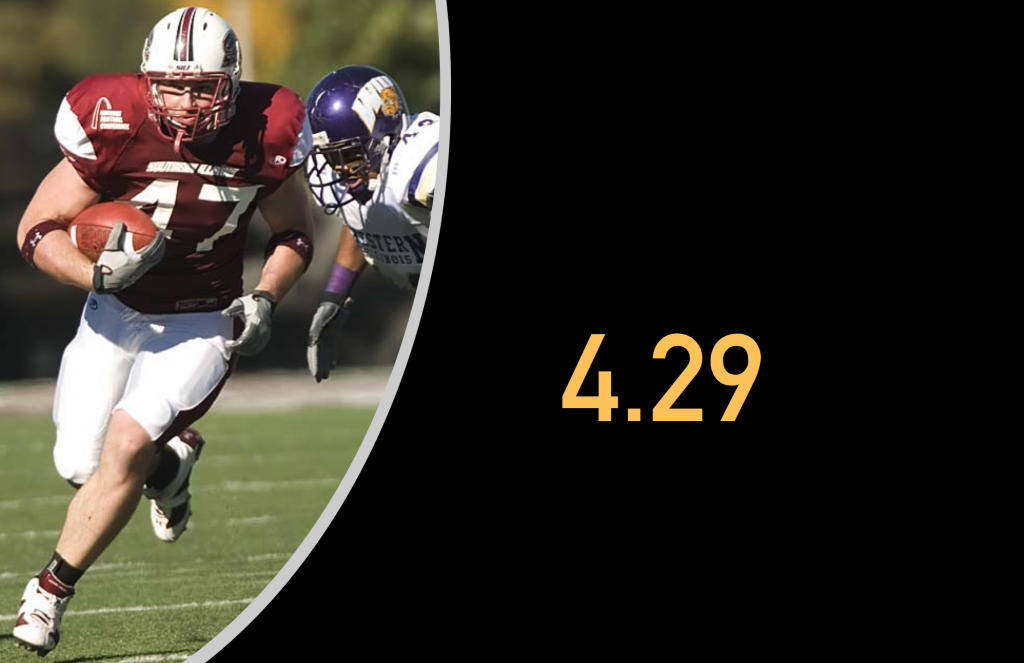
So, was Braden Jones a 4.29, a 4.43, or a 4.55? Braden was all three. It all depends on the venue, the surface, the shoes, the wind, the start, and the timing system. Damn, that’s a lot of variables! Times are only comparable when the variables are controlled. (Scientific Method!)
Kapri Bibbs also ran for me. In his senior year, Kapri’s average 40 time was 4.36. Three years later, Kapri scored 31 touchdowns for Colorado State and was invited to the NFL Combine. Kapri ran a dismal 4.67 at the combine, complaining of turf toe. Later, at his Pro Day at Colorado State, Kapri ran 4.47. Was Kapri a 4.36, 4.47, or 4.67? It’s all is variable-dependent.
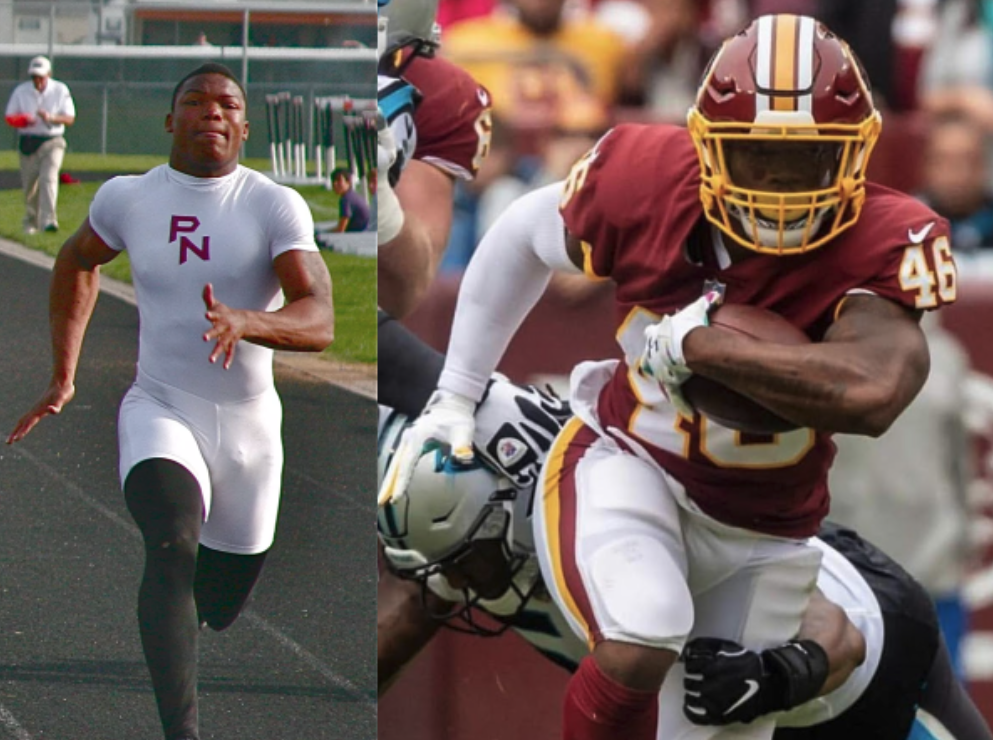
So, is the 40 meaningless? Hell no! The 40s ran with controlled variables at Plainfield North are meaningful and significant. The 40s ran with controlled variables at the NFL combine are meaningful and significant. However you can’t compare the 40 times at Plainfield North to the 40 times at the NFL Combine.
Players who run fast 40s at the NFL combine get drafted high, sign huge contracts, and will most likely have long and successful careers in the NFL. Slow guys don’t.
Funny story… back in the olden days, scouts would never trust any times but their own (variables!). One scout timed a guy who ran much faster than expected. After a five minute recovery, the guy repeated his remarkable time. The scout called his team’s front office with the exciting news. The super-fast 40 time caused an NFL team to use an early pick on the guy who turned out to be a bust. Two years later, the discouraged scout went back to the field where he had timed the guy. The scout measured from the goal line to the 40 yard line. He found the distance to be 38 yards. Variables!
You Really Want Verified Times?
Run track.
That’s the answer to this complicated riddle.
Track times are verified. Track times are true. College football coaches don’t trust a high school coach who claims his running back runs 4.4 in the forty. However, when high school football coaches share track numbers, college football coaches listen.
That’s why Tracking Football is revolutionizing college recruiting. If you run 10.31 with +0.2 m/sec wind, that’s a verified, wind-legal time… and it’s fast! College football coaches are now paying attention to track and field metrics like never before.
Running track is win-win. Just the fact that a kid runs track is now highly valued by college football coaches. Sorry 7on7 get-rich-off-of-gullible-kids entrepreneurs!
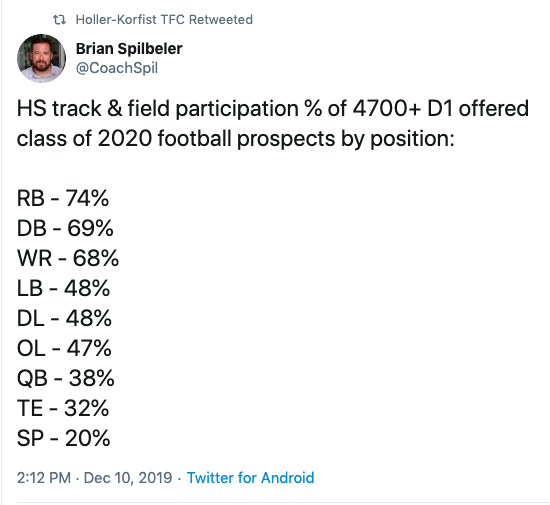
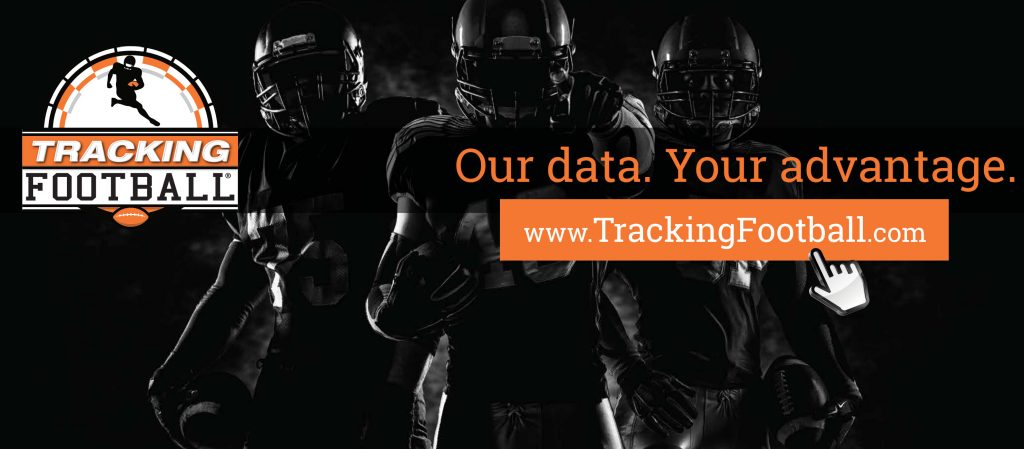
In 2001, I talked to an assistant football coach from the University of Wisconsin. I told him that 6’3″, 210-pound, Braden Jones was a great football player who long jumped 23’4″ and ran the 400 in 48.8. The coach responded, “Is that good?”
Thank God for Tracking Football. I love the 40 but I’m also thankful that football coaches have discovered truly verifiable times (and distances).
+++
Tony Holler (630) 849-8294, tony.holler@yahoo.com
+++
Feed the Cats Track Bundle – 50% off the Feed the Cats Certification Track Package
Feed the Cats Football Bundle – 50% off the Feed the Cats Football Package
Want all the Feed the Cats stuff (track, football, speed)? Get them all for only $149. Click here.

Tony, I thought of you while reading the specs on the entering freshman football recruiting class at Stanford, ranked I believe 5th in NCAA Div. I. The number of multi-sport athletes, particularly in track but also basketball, etc., made me smile. SO much speed in football nowadays on both sides of the ball!
It’s like track & field on turf!